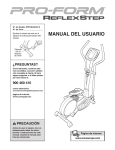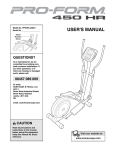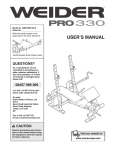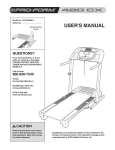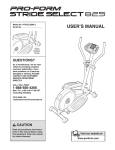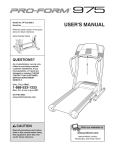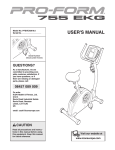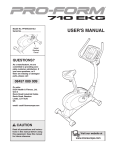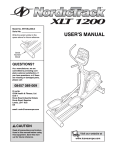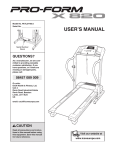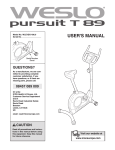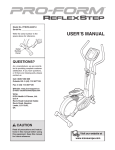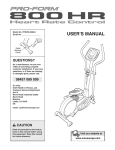Download ProForm PFEVEL2786.0 User`s manual
Transcript
Model No. PFEVEL2786.0 Serial No. USER'S MANUAL Serial Number Decal QUESTIONS? As a manufacturer, we are committed to providing complete customer satisfaction. If you have questions, or if there are missing or damaged parts, please call: 08457 089 009 Or write: ICON Health & Fitness, Ltd. Unit 4 Revie Road Industrial Estate Revie Road, Beeston Leeds, LS11 8JG UK email: [email protected] CAUTION Read all precautions and instructions in this manual before using this equipment. Keep this manual for future reference. Visit our website at www.iconeurope.com TABLE OF CONTENTS IMPORTANT PRECAUTIONS . . . . . . . . . . . . . . . . . . . . . . . . . . . . . . . . . . . . . . . . . . . . . . . . . . . . . . . . . . . . . . . .2 BEFORE YOU BEGIN . . . . . . . . . . . . . . . . . . . . . . . . . . . . . . . . . . . . . . . . . . . . . . . . . . . . . . . . . . . . . . . . . . . . . .3 ASSEMBLY . . . . . . . . . . . . . . . . . . . . . . . . . . . . . . . . . . . . . . . . . . . . . . . . . . . . . . . . . . . . . . . . . . . . . . . . . . . . . . .4 HOW TO USE THE ELLIPTICAL EXERCISER . . . . . . . . . . . . . . . . . . . . . . . . . . . . . . . . . . . . . . . . . . . . . . . . . . .9 MAINTENANCE AND TROUBLESHOOTING . . . . . . . . . . . . . . . . . . . . . . . . . . . . . . . . . . . . . . . . . . . . . . . . . . .19 CONDITIONING GUIDELINES . . . . . . . . . . . . . . . . . . . . . . . . . . . . . . . . . . . . . . . . . . . . . . . . . . . . . . . . . . . . . . .20 PART LIST . . . . . . . . . . . . . . . . . . . . . . . . . . . . . . . . . . . . . . . . . . . . . . . . . . . . . . . . . . . . . . . . . . . . . . . . . . . . . .22 EXPLODED DRAWING . . . . . . . . . . . . . . . . . . . . . . . . . . . . . . . . . . . . . . . . . . . . . . . . . . . . . . . . . . . . . . . . . . . .23 ORDERING REPLACEMENT PARTS . . . . . . . . . . . . . . . . . . . . . . . . . . . . . . . . . . . . . . . . . . . . . . . . . .Back Cover IMPORTANT PRECAUTIONS WARNING: To reduce the risk of serious injury, read the following important precautions before using the elliptical exerciser. 1. Read all instructions in this manual and all warnings on the elliptical exerciser before using the elliptical exerciser. 7. The elliptical exerciser should not be used by persons weighing more than 250 pounds (113 kg). 2. It is the responsibility of the owner to ensure that all users of the elliptical exerciser are adequately informed of all precautions. 8. Wear appropriate exercise clothes when using the elliptical exerciser. Always wear athletic shoes for foot protection while exercising. 3. The elliptical exerciser is intended for home use only. Do not use the elliptical exerciser in a commercial, rental, or institutional setting. 9. When mounting and dismounting the elliptical exerciser, always hold the handlebars and step onto and off the pedal that is in the lowest position. 4. Keep the elliptical exerciser indoors, away from moisture and dust. Place the elliptical exerciser on a level surface, with a mat beneath it to protect the floor or carpet. Make sure that there is enough clearance around the elliptical exerciser to mount, dismount, and use it. 10. The pulse sensor is not a medical device. Various factors may affect the accuracy of heart rate readings. The pulse sensor is intended only as an exercise aid in determining heart rate trends in general. 11. Keep your back straight when using the elliptical exerciser; do not arch your back. 5. Inspect and properly tighten all parts regularly. Replace any worn parts immediately. 12. If you feel pain or dizziness while exercising, stop immediately and cool down. 6. Keep children under 12 and pets away from the elliptical exerciser at all times. 13. When you stop exercising, allow the pedals to slowly come to a stop. WARNING: Before beginning this or any exercise program, consult your physician. This is especially important for persons over the age of 35 or persons with pre-existing health problems. Read all instructions before using. ICON assumes no responsibility for personal injury or property damage sustained by or through the use of this product. 2 BEFORE YOU BEGIN Thank you for selecting the new PROFORM® 470 HR low-impact elliptical exerciser. The 470 HR is an incredibly smooth exerciser that moves your feet in a natural elliptical path, minimizing the impact on your knees and ankles. Welcome to a whole new world of natural, elliptical-motion exercise. tions after reading this manual, please see the front cover of this manual. To help us assist you, note the product model number and serial number before contacting us. The model number is PFEVEL2786.0. The serial number can be found on a decal attached to the elliptical exerciser (see the front cover of this manual). For your benefit, read this manual carefully before you use the elliptical exerciser. If you have ques- Before reading further, please familiarize yourself with the parts that are labeled in the drawing below. Handlebar Console Pulse Sensor Upright FRONT Pedal Side Shield Transport Wheel Pedal Disc The decal shown above has been placed on the elliptical exerciser. If the decal is missing or illegible, call the telephone number on the front cover of this manual and order a free replacement decal. Apply the decal in the location shown. BACK 3 ASSEMBLY Assembly requires two persons. Place all parts of the elliptical exerciser in a cleared area and remove the packing materials. Do not dispose of the packing materials until assembly is completed. Assembly requires a phillips screwdriver and a rubber mallet . , an adjustable wrench , See the drawings below to identify the small parts needed for assembly. The number in parentheses below each drawing is the key number of the part, from the PART LIST on page 22. The number following the key number is the quantity needed for assembly. Note: Some small parts may have been preassembled. If a part is not in the parts bag, check to see if it has been preassembled. M6 Washer (55)–2 M6 Nylon Locknut (56)–6 M8 Washer (52)–4 M6 Arc Washer (39)–4 M8 Nylon Locknut (57)–4 M6 x 1 3/8" Button Bolt (46)–4 M8 Cap Nut (24)–2 Console Screw (68)–4 M4 x 1/2" Screw (49)–16 M8 x 1 9/16" Hex Bolt (41)–4 M8 x 5/8" Button Screw (45)–6 M6 x 2 1/2" Button Shoulder Bolt (40)–2 M8 Arc Washer (54)–8 M8 x 3 3/8" Button Screw (42)–2 M8 x 3 1/2" Carriage Bolt (51)–2 4 1. Identify the Front Stabilizer (2), which has Transport Wheels (29) attached to it. Attach the Front Stabilizer to the Frame (1) with two M8 x 3 1/2" Carriage Bolts (51), two M8 Arc Washers (54), and two M8 Cap Nuts (24). 1 29 51 24 54 1 2 29 54 24 2. With the help of another person, raise the Frame (1) up onto its front end. While the other person holds the Frame, attach the Rear Stabilizer (20) to the Frame with two M8 x 3 3/8" Button Screws (42). With the help of another person, lower the Frame (1) so that it rests on the Rear Stabilizer (20) and the Front Stabilizer (not shown). 2 20 42 1 3. While another person holds the Upright (3) near the Frame (1), connect the Upper Wire Harness (75) to the Reed Switch Wire (67). 3 54 Slide the Upright (3) onto the Frame (1). Be careful to avoid pinching the wires. Align the holes in the Upright with the holes in the Frame. Attach the Upright with six M8 x 5/8" Button Screws (45) and six M8 Arc Washers (54). 3 45 54 54 45 45 54 54 Avoid pinching the wires during this step 75 67 1 5 4. The Console (22) requires four “AA” batteries; alkaline batteries are recommended. Remove the battery cover from the back of the Console and insert four batteries into the Console; make sure that the batteries are oriented as shown by the diagram inside the Console. Then, reattach the battery cover. 4 Battery Cover 22 5. While another person holds the Console (22) near the top of the Upright (3), connect the console wire to the Upper Wire (75). Then, connect the lower wire on the back of the console to the upper wire on the back of the console. Batteries 5 22 Attach the Console (22) to the Upright (3) with four Console Screws (68). Be careful to avoid pinching the wires. 75 Note: If you have purchased the optional pulse sensor (see page 19 for more information), disregard the instructions for installing the receiver. The console on this elliptical exerciser already has a receiver installed. 6. Identify the Right Pedal (63), which has an “R” molded into its bottom surface, and the Right Pedal Tube (64), which is marked with a sticker. Console Wire 68 Avoid pinching the wires during this step 3 6 41 Attach the Right Pedal (63) to the Right Pedal Tube (64) with two M8 x 1 9/16" Hex Bolts (41), two M8 Washers (52), and two M8 Nylon Locknuts (57). 4 8 Attach the Left Pedal (8) to the Left Pedal Tube (4) in the same way. 63 64 52 52 6 57 7. Slide a Pedal Tube Cover (78) onto the Right Handlebar Leg (71). 7 Apply a thin film of the included grease to the parts shown at the right. Next, attach the Right Pedal Tube (64) to the Right Handlebar Leg (71) with an M6 x 2 1/2" Button Shoulder Bolt (40), an M6 Washer (55), and an M6 Nylon Locknut (56). 71 5 78 4 56 Repeat this step to attach the Left Pedal Tube (4) to the Left Handlebar Leg (5). 55 Grease Grease 40 64 8. Attach the right Pedal Tube Cover (78) to the Right Pedal Tube (64) with two M4 x 1/2" Screws (49). 8 49 Repeat this step for the Left Pedal Tube (4). 4 78 64 9. Insert a Plastic Sleeve (16) and a Handlebar (6) into the top of the Right Handlebar Leg (71). Align the holes in the Plastic Sleeve and the Handlebar with the holes in the Right Handlebar Leg. Then, attach the Handlebar with two M6 x 1 3/8" Button Bolts (46), two M6 Arc Washers (39), and two M6 Nylon Locknuts (56). 9 6 6 Repeat this step to attach the other Handlebar (6) to the Left Handlebar Leg (5). 16 46 56 5 39 56 7 71 10. Attach a Right Rear Pivot Cover (72) and a Right Front Pivot Cover (73) around the right Handlebar (6) and the Right Handlebar Leg (71) with six M4 x 1/2" Screws (49). 10 6 6 49 Repeat this step for the left Handlebar (6) and the Left Handlebar Leg (5). 73 49 49 72 49 71 5 11. Make sure that all parts of the elliptical exerciser are properly tightened. Note: Some hardware may be left over after assembly is completed. To protect the floor or carpet from damage, place a mat under the elliptical exerciser. 8 HOW TO USE THE ELLIPTICAL EXERCISER HOW TO MOVE THE ELLIPTICAL EXERCISER HOW TO EXERCISE ON THE ELLIPTICAL EXERCISER Due to the size and weight of the elliptical exerciser, moving it requires two persons. Stand in front of the elliptical exerciser, hold the upright, and place one foot against one of the transport wheels. Pull on the upright and have a second person lift the base until the elliptical exerciser will roll on the transport wheels. Carefully move the elliptical exerciser to the desired location, and then lower it to the floor. To mount the elliptical exerciser, firmly hold the handlebars and carefully step onto the pedal that is in the lower position. Next, step Pedal onto the other Pedal Disc pedal. Push the pedals until they begin to move with a continuous motion. Note: The pedal discs can turn in either direction. It is recommended that you turn the pedal discs in the direction shown above; however, for variety, you can turn the pedal discs in the opposite direction. Pull on upright Place your foot here To dismount the elliptical exerciser, allow the pedals to come to a complete stop. The elliptical exerciser does not have a freewheel; the pedals will continue to move until the flywheel stops. When the pedals are stationary, step off the higher pedal first. Then, step off the lower pedal. To add upper-body exercise to your workouts on the elliptical exerciser, push and pull the handlebars to work your arms, shoulders, and back. Lift here 9 Handlebars CONSOLE DIAGRAM FEATURES OF THE CONSOLE The console offers a selection features designed to make your workouts more effective. When you use the manual mode of the console, you can change the resistance of the pedals with the touch of a button. As you exercise, the console will provide continuous exercise feedback. You can even monitor your heart rate using the handgrip pulse sensor or the optional chest pulse sensor. (For information about the optional chest pulse sensor, see page 19.) The console also features six smart programs that automatically change the resistance of the pedals and prompt you to vary your pedaling pace while guiding you through an effective workout. The console also offers two heart rate programs that automatically control the resistance of the pedals and prompt you to maintain a constant pedaling pace to keep your heart rate near target heart rate settings during your workouts. In addition, the console features iFIT.com interactive technology. Having iFIT.com interactive technology is like having a personal trainer in your home. Using the included audio cable, you can connect the elliptical exerciser to your home stereo, portable stereo, computer, or VCR and play special iFIT.com CD and video programs (iFIT.com CDs and videocassettes are available separately). iFIT.com CD and video programs automatically control the resistance of the pedals and prompt you to vary your pace as a personal trainer coaches you through every step of your workout. Highenergy music provides added motivation. To purchase iFIT.com CDs and videocassettes, visit our Web site at www.iconeurope.com. With the elliptical exerciser connected to your computer, you can also go to our Web site at www.iFIT.com and access programs directly from the Internet. Explore www.iFIT.com for more information. To use the manual mode of the console, follow the steps beginning on page 11. To use a smart program, see page 12. To use a heart rate program, see page 13. To use an iFIT.com CD or video program, see page 17. To use a program directly from our Web site, see page 18. Before using the console, make sure that batteries are installed (see assembly step 4 on page 6). If there is a sheet of clear plastic on the display, remove the plastic. 10 The third section of the display will show the approximate number of calories you have burned and the resistance level of the pedals. The display will change modes every few seconds. The display will also show your heart rate when you use the handgrip pulse sensor. HOW TO USE THE MANUAL MODE 1 Turn on the console. To turn on the console, press any button or begin pedaling. The display will light and the console will be ready for use. 2 Select the manual mode. The lower section of the display will show a track representing 640 revolutions. As you exercise, indicators will appear in succession around the track until the entire track appears. The track will then disappear and the indicators will again begin to appear in succession Each time you turn on the console, the manual mode will be selected. If you have selected a program, reselect the manual mode by pressing any of the Programs buttons repeatedly until zeroes appear in the display. 3 Begin pedaling and change the resistance of the pedals as desired. 5 If there are sheets Contacts of clear plastic on the metal contacts on the handgrip pulse sensor, remove the plastic. Next, hold the handgrip pulse sensor with your palms resting on the metal contacts. Avoid moving your hands or gripping the contacts too tightly. When your pulse is detected, a heart-shaped symbol will flash in the display each time your heart beats and then your heart rate will be shown. For the most accurate heart rate reading, hold the contacts for at least 15 seconds. As you pedal, change the resistance of the pedals by pressing the Increase and Decrease buttons. There are ten resistance levels. Note: After you press the buttons, it will take a moment for the pedals to reach the selected resistance level. 4 Measure your heart rate if desired. Follow your progress with the display. The upper section of the display will show the elapsed time and the distance (total number of revolutions) that you have pedaled. The display will change modes every few seconds. Note: When you select a program, with the exception of the second heart rate program, the display will show the time remaining in the program instead of the elapsed time. 6 When you are finished exercising, the console will turn off automatically. If the pedals do not move for a few seconds, the time will begin to flash in the display and the console will pause. If the pedals do not move for a few minutes and no buttons are pressed, the console will turn off and the display will be reset. The second section of the display will show your pedaling pace, in revolutions per minute (rpm). 11 As you exercise, the display will prompt you to keep your pedaling pace near the pace setting for the current segment. When the word “faster” appears in the display, increase your pace. When the word “slower” appears, decrease your pace. When the center of the target flashes, maintain your current pace. HOW TO USE A SMART PROGRAM 1 Turn on the console. To turn on the console, press any button or begin pedaling. The display will light and the console will be ready for use. 2 Select a smart program. Important: The pace settings are intended only to provide motivation. Your actual pace may be slower than the pace settings. Make sure to exercise at a pace that is comfortable for you. To select a smart program, press the Program Select button repeatedly until P3, P4, P5, P6, P7, or P8 appears in the display. The upper section of the display will show how long the program will last. 3 If you stop pedaling for several seconds, the time will begin to flash in the display. To restart the program, simply resume pedaling. Begin pedaling to start the program. The program will continue until the display shows a time of 0:00. If you continue to pedal after the program is completed, the display will continue to show exercise feedback; however, the display will not show the elapsed time until you select the manual mode or a new program. Each program is divided into 30 one-minute segments. One resistance level and one pace setting are programmed for each segment. Note: The same resistance level and/or pace setting may be programmed for two or more consecutive segments. 4 Whenever the resistance is about to change, the resistance level will flash in the display for a few seconds to alert you. The resistance of the pedals will then automatically change to the resistance level programmed for the next segment. Note: If the resistance level is too low or too high, you can override it by pressing the Increase and Decrease buttons. However, when the current segment ends, the resistance will automatically change to the resistance level programmed for the next segment. Follow your progress with the display. See step 4 on page 11. 5 Measure your heart rate if desired. See step 5 on page 11. 6 When you are finished exercising, the console will automatically turn off. See step 6 on page 11. 12 If you select the second heart rate program, the target heart rate setting for the program will appear in the display. Use the Increase and Decrease buttons to change the target heart rate setting, if desired (see EXERCISE INTENSITY on page 20). Note: The same target heart rate setting will be used for the entire program. HOW TO USE A HEART RATE PROGRAM 1 Turn on the console. To turn on the console, press any button or begin pedaling. The display will light and the console will be ready for use. 2 4 Select a heart rate program. It is not necessary to hold the handgrip pulse sensor continuously during a heart rate program; however, you should hold the handgrip pulse sensor frequently for the program to operate properly. Each time you hold the handgrip pulse sensor, keep your hands on the metal contacts for at least 30 seconds. To select one of the two heart rate programs, press the button with the heart rate symbol once or twice until P1 or P2 appears in the display. The upper section of the display will show how long the program will last. 3 Hold the handgrip pulse sensor. 5 Begin pedaling to start the program. The first heart rate control program—This program is divided into 30 one-minute segments. One target heart rate setting is programmed for each segment. Note: The same target heart rate setting may be programmed for two or more consecutive segments. Enter a target heart rate setting. If you select the first heart rate program, the maximum target heart rate setting of the program will appear in the display. Use the Increase and Decrease buttons to change the maximum heart rate setting, if desired (see EXERCISE INTENSITY on page 20). Note: If you change the maximum target heart rate setting, the intensity level of the entire program will change. The second heart rate program—The same target heart rate setting is programmed for all segments of this program. 13 Both heart rate programs—As you pedal, the console will regularly compare your heart rate to the target heart rate setting. If your heart rate is too far below or above the target heart rate, the resistance of the pedals will automatically increase or decrease to bring your heart rate closer to the target heart rate setting. HOW TO CONNECT YOUR CD PLAYER, VCR OR COMPUTER To use iFIT.com CDs, the elliptical exerciser must be connected to your portable CD player, portable stereo, home stereo, or computer with CD player. See pages 14 to 16 for connecting instructions. To use iFIT.com videocassettes, the elliptical exerciser must be connected to your VCR. See page 16 for connecting instructions. To use iFIT.com programs directly from our Web site, the elliptical exerciser must be connected to your computer. See page 16. You will also be prompted to pedal at a steady pace. When the word “faster” appears in the display, increase your pace. When the word “slower” appears, decrease your pace. When the center of the target flashes, maintain your current pace. Important: Make sure to exercise at a pace that is comfortable for you. HOW TO CONNECT YOUR PORTABLE CD PLAYER Note: If your CD player has separate LINE OUT and PHONES jacks, see instruction A below. If your CD player has only one jack, see instruction B. Note: You can manually override the resistance settings; however, if you change the resistance setting, you might not maintain the target heart rate. Also, when the console compares your heart rate to the target heart rate setting, the resistance of the pedals may automatically increase or decrease to bring your heart rate closer to the target heart rate setting. A. Plug one end of the audio cable into the jack beneath the console. Plug the other end of the audio cable into the LINE OUT jack on your CD player. Plug your headphones into the PHONES jack. A PHONES LINE OUT 6 Follow your progress with the display. LINE OUT PHONES See step 4 on page 11. 7 Headphones Audio Cable Measure your heart rate if desired. See step 5 on page 11. 8 When you are finished exercising, the console will turn off automatically. B. See step 6 on page 11. Plug one end of the audio cable into the jack beneath the console. Plug the other end of the audio cable into the splitter. Plug the splitter into the PHONES jack on your CD player. Plug your headphones into the other side of the splitter. B PHONES PHONES Audio Cable Splitter Headphones 14 HOW TO CONNECT YOUR PORTABLE STEREO HOW TO CONNECT YOUR HOME STEREO Note: If your stereo has an RCA-type AUDIO OUT jack, see instruction A below. If your stereo has a 3.5mm LINE OUT jack, see instruction B. If your stereo has only a PHONES jack, see instruction C. Note: If your stereo has an unused LINE OUT jack, see instruction A below. If the LINE OUT jack is being used, see instruction B. A. Plug one end of the audio cable into the jack beneath the console. Plug the other end of the audio cable into the adapter. Plug the adapter into the LINE OUT jack on your stereo. A. Plug one end of the audio cable into the jack beneath the console. Plug the other end of the audio cable into the adapter. Plug the adapter into an AUDIO OUT jack on your stereo. A CD A/B VCR AUDIO OUT Amp LINE OUT RIGHT LEFT Audio Cable LINE OUT adapter Audio Cable B. See the drawing above. Plug one end of the audio cable into the jack beneath the console. Plug the other end of the audio cable into the LINE OUT jack on your stereo. Do not use the adapter. adapter B. Plug one end of the audio cable into the jack beneath the console. Plug the other end of the audio cable into the adapter. Plug the adapter into an RCA Y-adapter (available at electronics stores). Next, remove the wire that is currently plugged into the LINE OUT jack on your stereo and plug the wire into the unused side of the Y-adapter. Plug the Y-adapter into the LINE OUT jack on your stereo. C. Plug one end of the audio cable into the jack beneath the console. Plug the other end of the audio cable into the splitter. Plug the splitter into the PHONES jack on your stereo. Plug your headphones into the other side of the splitter. B CD C VCR Amp LINE OUT PHONES Audio Cable RCA Y-adapter Splitter Audio Cable adapter Headphones Wire removed from LINE OUT jack 15 HOW TO CONNECT YOUR COMPUTER HOW TO CONNECT YOUR VCR Note: If your computer has a 3.5mm LINE OUT jack, see instruction A. If your computer has only a PHONES jack, see instruction B. Note: If your VCR has an unused AUDIO OUT jack, see instruction A below. If the AUDIO OUT jack is being used, see instruction B. If you have a TV with a built-in VCR, see instruction B. If your VCR is connected to your home stereo, see HOW TO CONNECT YOUR HOME STEREO on page 15. A. Plug one end of the audio cable into the jack beneath the console. Plug the other end of the audio cable into the LINE OUT jack on your computer. A. Plug one end of the audio cable into the jack beneath the console. Plug the other end of the audio cable into the adapter. Plug the adapter into the AUDIO OUT jack on your VCR. A LINE OUT A ANT. IN VIDEO AUDIO IN RF OUT CH 3 4 OUT Audio Cable AUDIO OUT RIGHT LEFT adapter Audio Cable B. Plug one end of the audio cable into the jack beneath the console. Plug the other end of the audio cable into the splitter. Plug the splitter into the PHONES jack on your computer. Plug your headphones or speakers into the other side of the splitter. B. Plug one end of the audio cable into the jack beneath the console. Plug the other end of the audio cable into the adapter. Plug the adapter into an RCA Y-adapter (available at electronics stores). Next, remove the wire that is currently plugged into the AUDIO OUT jack on your VCR and plug the wire into the unused side of the Y-adapter. Plug the Y-adapter into the AUDIO OUT jack on your VCR. B PHONES Audio Cable Splitter B ANT. IN VIDEO AUDIO IN RF OUT CH 3 4 OUT Headphones/Speakers RCA Y-adapter Audio Cable adapter Wire removed from AUDIO OUT jack 16 The program will function in almost the same way as a smart program (see step 3 on page 12). However, an electronic “chirping” sound will alert you when the resistance level and/or the target pace is about to change. HOW TO USE AN IFIT.COM CD OR VIDEO PROGRAM To use iFIT.com CDs or videocassettes, the elliptical exerciser must be connected to your portable CD player, portable stereo, home stereo, computer with CD player, or VCR. See HOW TO CONNECT YOUR CD PLAYER, VCR, OR COMPUTER on page 14. To purchase iFIT.com CDs and videocassettes, visit our Web site at www.iFIT.com. Note: If the resistance of the pedals and/or the target pace does not change when a “chirp” sounds: • Make sure that the indicator near the iFIT button is lit. • Adjust the volume of your CD player or VCR. If the volume is too high or too low, the console may not detect the program signals. Follow the steps below to use an iFIT.com CD or video program. 1 Turn on the console. • Make sure that the audio cable is properly connected and that it is fully plugged in. See step 1 on page 11. 2 5 Select the iFIT.com mode. See step 4 on page 11. To select the iFIT.com mode, press the iFIT button. 3 6 Insert the iFIT.com CD or videocassette. Measure your heart rate if desired. See step 5 on page 11. If you are using an iFIT.com CD, insert the CD into your CD player. If you are using an iFIT.com videocassette, insert the videocassette into your VCR. 4 Follow your progress with the display. 7 When you are finished exercising, the console will turn off automatically. See step 6 on page 11. Press the play button on your CD player or VCR. A moment after you press the play button, your personal trainer will begin guiding you through your workout. Simply follow your personal trainer’s instructions. 17 HOW TO USE A PROGRAM DIRECTLY FROM OUR WEBSITE Our Web site at www.iFIT.com allows you to play iFIT.com programs directly from the Internet. To use programs from our Web site, the elliptical exerciser must be connected to your home computer. See HOW TO CONNECT YOUR COMPUTER on page 16. In addition, you must have an Internet connection and an Internet service provider. A list of specific system requirements is found on our Web site. 5 Follow the desired links on our Web site to select a program. 6 Follow the online instructions to start the program. When you start the program, an on-screen countdown will begin. 7 When the on-screen countdown ends, the program will begin. The program will function in almost the same way as a smart program (see step 3 on page 12). However, an electronic “chirping” sound will alert you when the resistance level and/or the target pace is about to change. Follow the steps below to use a program from our Web site. 1 Turn on the console. See step 1 on page 11. 2 Return to the elliptical exerciser and begin pedaling. 8 Select the iFIT.com mode. Follow your progress with the display. See step 4 on page 11. To select the iFIT.com mode, press the iFIT button. 9 Measure your heart rate if desired. See step 5 on page 11. 3 Go to your computer and start an Internet connection. 4 Start your Web browser, if necessary, and go to our Web site at www.iFIT.com. 10 When you are finished exercising, the console will turn off automatically. See step 6 on page 11. 18 THE OPTIONAL CHEST PULSE SENSOR The optional chest pulse sensor provides hands-free operation and continuously monitors your heart rate during your workouts. To purchase the optional chest pulse sensor, call the telephone number on the front cover of this manual. MAINTENANCE AND TROUBLESHOOTING Inspect and properly tighten all parts of the elliptical exerciser regularly. Replace any worn parts immediately. CONSOLE TROUBLESHOOTING If the console does not function properly, the batteries should be replaced. To replace the batteries, see assembly step 4 on page 6. The elliptical exerciser can be wiped clean with a soft cloth and mild detergent. Do not use abrasives or solvents. To prevent damage to the console, keep liquids away from the console and keep the console out of direct sunlight. HANDGRIP PULSE SENSOR TROUBLESHOOTING If the handgrip pulse sensor does not function properly, see step 5 on page 11. When storing the elliptical exerciser, remove the batteries from the console. Keep the elliptical exerciser in a clean, dry location, away from moisture and dust. 19 CONDITIONING GUIDELINES Fat Burning WARNING: To burn fat effectively, you must exercise at a relatively low intensity level for a sustained period of time. During the first few minutes of exercise, your body uses easily accessible carbohydrate calories for energy. Only after the first few minutes of exercise does your body begin to use stored fat calories for energy. If your goal is to burn fat, adjust the intensity of your exercise until your heart rate is near the lowest number or the middle number in your training zone as you exercise. Before beginning this or any exercise program, consult your physician. This is especially important for individuals over the age of 35 or individuals with pre-existing health problems. The pulse sensor is not a medical device. Various factors may affect the accuracy of heart rate readings. The pulse sensor is intended only as an exercise aid in determining heart rate trends in general. Aerobic Exercise If your goal is to strengthen your cardiovascular system, your exercise must be “aerobic.” Aerobic exercise is activity that requires large amounts of oxygen for prolonged periods of time. This increases the demand on the heart to pump blood to the muscles, and on the lungs to oxygenate the blood. For aerobic exercise, adjust the intensity of your exercise until your heart rate is near the highest number in your training zone. The following guidelines will help you to plan your exercise program. Remember that proper nutrition and adequate rest are essential for successful results. EXERCISE INTENSITY Whether your goal is to burn fat or to strengthen your cardiovascular system, the key to achieving the desired results is to exercise with the proper intensity. The proper intensity level can be found by using your heart rate as a guide. The chart below shows recommended heart rates for fat burning, maximum fat burning, and cardiovascular (aerobic) exercise. WORKOUT GUIDELINES Each workout should include the following three parts: A warm-up, consisting of 5 to 10 minutes of stretching and light exercise. A proper warm-up increases your body temperature, heart rate, and circulation in preparation for exercise. Training zone exercise, consisting of 20 to 30 minutes of exercising with your heart rate in your training zone. (During the first few weeks of your exercise program, do not keep your heart rate in your training zone for longer than 20 minutes.) A cool-down, with 5 to 10 minutes of stretching. This will increase the flexibility of your muscles and will help to prevent post-exercise problems. To find the proper heart rate for you, first find your age near the bottom of the chart (ages are rounded off to the nearest ten years). Next, find the three numbers above your age; the three numbers are your “training zone.” The lowest number is the recommended heart rate for fat burning; the middle number is the recommended heart rate for maximum fat burning; and the highest number is the heart rate for aerobic exercise. EXERCISE FREQUENCY To maintain or improve your condition, plan three workouts each week, with at least one day of rest between workouts. After a few months of regular exercise, you may complete up to five workouts each week, if desired. The key to success is make exercise a regular and enjoyable part of your everyday life. 20 SUGGESTED STRETCHES The correct form for several basic stretches is shown at the right. Move slowly as you stretch—never bounce. 1 1. Toe Touch Stretch Stand with your knees bent slightly and slowly bend forward from your hips. Allow your back and shoulders to relax as you reach down toward your toes as far as possible. Hold for 15 counts, then relax. Repeat 3 times. Stretches: Hamstrings, back of knees, and back. 2 2. Hamstring Stretch Sit with one leg extended. Bring the sole of the opposite foot toward you and rest it against the inner thigh of your extended leg. Reach toward your toes as far as possible. Hold for 15 counts, then relax. Repeat 3 times for each leg. Stretches: Hamstrings, lower back, and groin. 3. Calf/Achilles Stretch With one leg in front of the other, reach forward and place your hands against a wall. Keep your back leg straight and your back foot flat on the floor. Bend your front leg, lean forward and move your hips toward the wall. Hold for 15 counts, then relax. Repeat 3 times for each leg. To cause further stretching of the achilles tendons, bend your back leg as well. Stretches: Calves, achilles tendons, and ankles. 4. Quadriceps Stretch With one hand against a wall for balance, reach back and grasp one foot with your other hand. Bring your heel as close to your buttocks as possible. Hold for 15 counts, then relax. Repeat 3 times for each leg. Stretches: Quadriceps and hip muscles. 21 3 4 PART LIST—Model No. PFEVEL2786.0 Key No. Qty. 1 2 3 4 5 6 7 8 9 10 11 12 13 14 15 16 17 18 19 20 21 22 23 24 25 26 27 28 29 30 31 32 33 34 35 36 37 38 39 40 41 42 43 1 1 1 1 1 2 1 1 1 1 2 1 2 1 1 2 8 1 2 1 1 1 4 2 2 4 2 2 2 1 2 4 2 2 2 1 2 2 4 2 4 2 1 Description Key No. Qty. Frame Front Stabilizer Upright Left Pedal Tube Left Handlebar Leg Handlebar Flywheel Left Pedal Flywheel Axle “C” Magnet Upright Spacer Left Rear Pivot Cover Handlebar Endcap Driving Wheel Assembly Right Crank Arm Plastic Sleeve Handlebar Bushing Spring Foam Handle Grip Rear Stabilizer Left Side Shield Console Leg Bushing M8 Cap Nut Pedal Disc M8 x 3/4" Hex Bolt Disc Cover Rear Stabilizer Endcap Transport Wheel Drive Belt Plastic Washer Nylon Bushing Flywheel Bearing Crank Bearing Pedal Tube Endcap “C” Clip Eyebolt Adjustment Bracket M6 Arc Washer M6 x 2 1/2" Button Shoulder Bolt M8 x 1 9/16" Hex Bolt M8 x 3 3/8" Button Screw M8 x 2 3/8" Hex Bolt 44 45 46 47 48 49 50 51 52 53 54 55 56 57 58 59 60 61 62 63 64 65 66 67 68 69 70 71 72 73 74 75 76 77 78 79 80 81 82 83 84 # # 1 6 4 10 5 24 4 2 5 4 8 2 8 8 1 1 1 1 2 1 1 1 6 1 5 1 1 1 1 1 1 1 2 2 2 1 1 1 1 2 1 1 1 R0906A Description M8 x 2 3/8" Tap Hex Bolt M8 x 5/8" Button Screw M6 x 1 3/8" Button Bolt M5 x 5/8" Button Screw M4 x 1 9/16" Button Screw M4 x 1/2" Screw Wave Washer M8 x 3 1/2" Carriage Bolt M8 Washer M10 Washer M8 Arc Washer M6 Washer M6 Nylon Locknut M8 Nylon Locknut M10 Nylon Locknut M8 Hex Nut Magnet Clamp M10 Spacer Right Pedal Right Pedal Tube Right Side Shield M4 x 3/4" Screw Reed Switch/Wire Console Screw Left Front Pivot Cover Lower Cable Right Handlebar Leg Right Rear Pivot Cover Right Front Pivot Cover Pulse Wire Upper Wire Rear Leg Cover Front Leg Cover Pedal Tube Cover Left Frame Cover Right Frame Cover Resistance Motor Resistance Cable Assembly Pulley Washer Resistance Pulley Assembly Tool User’s Manual Note: “#” indicates a non-illustrated part. Specifications are subject to change without notice. See the back cover of this manual for information about ordering replacement parts. 22 EXPLODED DRAWING—Model No. PFEVEL2786.0 R0906A 13 47 19 69 6 30 12 47 49 49 21 49 32 26 17 16 39 46 49 41 6 39 56 11 78 26 19 68 17 50 8 5 32 17 35 4 52 17 27 13 22 47 74 75 53 57 7 66 9 33 53 60 70 62 18 44 52 10 31 37 53 79 38 57 49 80 66 66 49 34 82 49 50 17 29 23 40 35 52 57 84 57 83 47 24 15 36 54 65 26 48 25 48 47 47 81 28 49 64 1 20 77 49 51 17 32 28 42 49 78 63 24 54 34 47 32 2 47 59 43 67 61 68 25 71 72 55 23 56 76 41 57 26 49 49 29 14 73 45 54 54 56 17 54 45 39 56 54 45 76 23 56 54 38 37 62 33 39 46 3 77 55 49 56 16 17 11 57 50 50 49 40 23 58 48 31 53 23 27 47 ORDERING REPLACEMENT PARTS To order replacement parts, contact the ICON Health & Fitness, Ltd. office, or write: ICON Health & Fitness, Ltd. Customer Service Department Unit 4, Revie Road Industrial Estate Revie Road Beeston Leeds, LS118JG UK Tel: 08457 089 009 Outside the UK: 0 (044) 113 387 7133 Fax: 0 (044) 113 387 7125 To help us assist you, please be prepared to give the following information: • the MODEL NUMBER of the product (PFEVEL2786.0) • the NAME of the product (PROFORM 470 HR elliptical exerciser) • the SERIAL NUMBER of the product (see the front cover of this manual) • the KEY NUMBER and DESCRIPTION of the part(s) (see pages 22 and 23) PROFORM is a registered trademark of ICON IP, Inc. Part No. 245639 R0906A Printed in China © 2006 ICON IP, Inc.
























